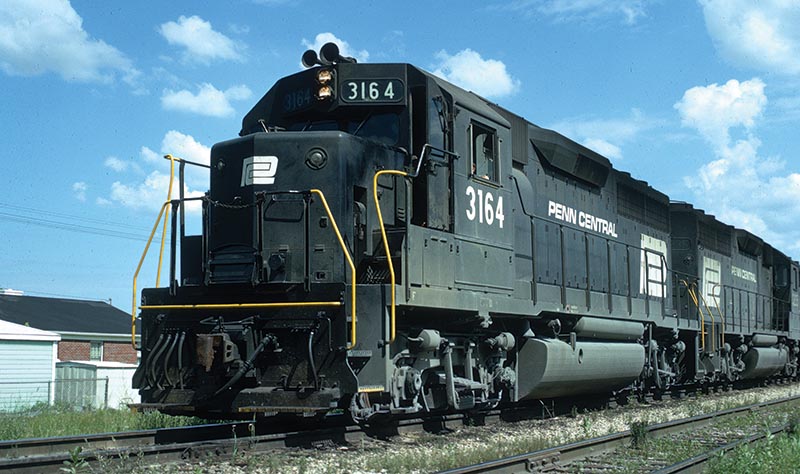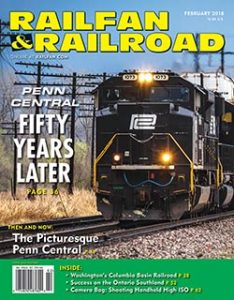 By Jerry W. Jordak/photos as noted
By Jerry W. Jordak/photos as noted
Working against the forces of gravity, an iron ore train powered by a half-dozen six-axle diesel locomotives grinds its way up the east slope of the Allegheny Mountains out of Altoona, Pa. Meanwhile, a trio of EMD GP40s speeds along the shore of Lake Erie with a train of new automobiles from Detroit heading to dealer showrooms in New England. Over in Indiana, an elderly geep picks its way along an overgrown branchline with bad track on a train with more crew members (five) than freight cars (three). And in New Jersey, passengers on a station platform take a few steps backward as a shiny, tubular aluminum passenger train streaks by on an express track at an amazing 150 m.p.h.
What do all of these vignettes have in common? They were everyday scenes on the modern mega-railroad everyone loves to hate — Penn Central.
An Unlikely Marriage
Railroads in the 1960s were facing unrelenting competition from trucks, airlines, and Interstate highways. The Interstate Commerce Commission, created in 1887 primarily to regulate the railroads, was slow to permit rate increases and often rejected railroads’ requests to abandon low-density, unprofitable branchlines. Employers began to move their manufacturing operations from the northeast to the south as a cost-saving measure, eroding the traffic base of the eastern railroads. Meanwhile, the Post Office was diverting the shipping and handling of mail away from railroads to air and truck transport, which doomed passenger trains.
To combat all of this, some lines looked to mergers as a way to reduce costs and stay in business. The modern railroad merger movement began with Norfolk & Western buying the Virginian in 1959. This was followed by the Erie and the Lackawanna joining forces in 1960; the Chesapeake & Ohio acquiring control of the Baltimore & Ohio in 1963; the N&W (again) acquiring control of the Nickel Plate and leasing the Wabash in 1964; and Atlantic Coast Line merging with Seaboard Air Line in 1967.
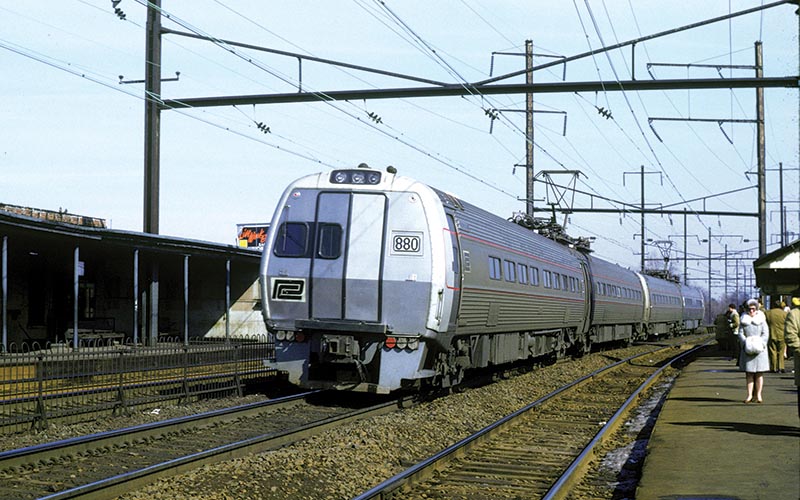
A Metroliner train speeds through Elizabeth, N.J. The high-speed rail program was a partnership between the Pennsylvania Railroad and the federal government. The first Metroliner trains entered service in 1969. Kevin EuDaly collection
The unlikely merger of the Pennsylvania and the New York Central was more than a decade in the making. The two railroads first began discussing a possible merger in 1957, but the talks never went anywhere and broke off in January 1959. Shortly after, the Central attempted to join the C&O-B&O merger, but was rebuffed.
By the end of 1961, as the other railroads in the east began making their plans to pair off, PRR and NYC saw themselves among the last on the dance floor and resumed talks in earnest. The following year, the boards of directors from both railroads gave their approval to the proposed merger. The ICC approved the merger in April 1966, but opposition by other railroads and the Department of Justice delayed the actual merger date until February 1, 1968.
A Rough Start
In a brief ceremony held just after midnight at 30th Street Station in Philadelphia, a car foreman walked up Track 1 to a business car marked “CENTRAL” and peeled off a sheet revealing the word “PENN” to a small group of gathered press and railroad officials. The simplicity of the event did not reflect the turmoil behind the scenes. To wit, former New York Central President Alfred E. Perlman elected to remain inside his private car during the unveiling, while former Pennsy head Stuart T. Saunders was nowhere to be found. It was an inauspicious start.
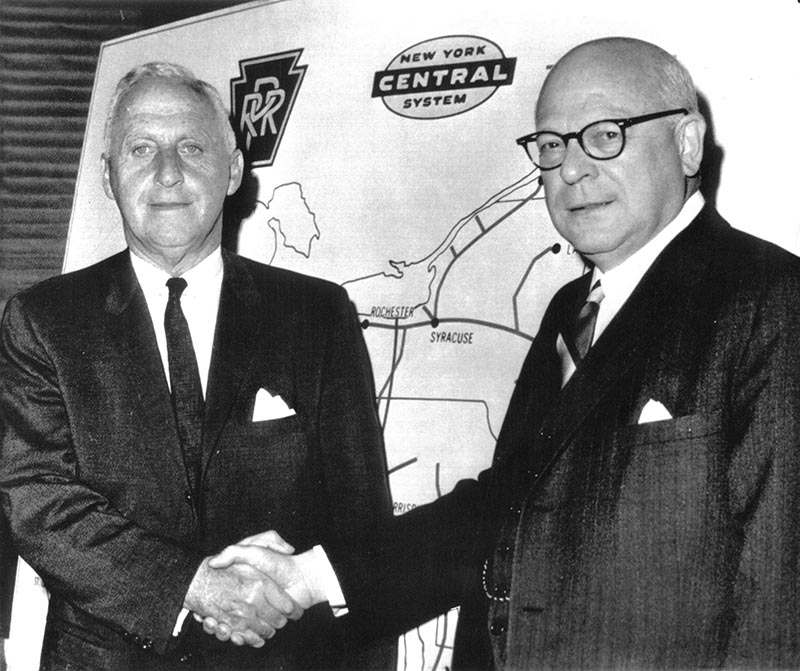
New York Central president Alfred E. Perlman and Pennsylvania Railroad chairman Stuart T. Saunders shake hands at a press event announcing the merger agreement that would form Penn Central. Gary Farmer collection
The new company hoped to integrate the two railroads immediately and quickly realize some of the merger’s expected cost-savings. Instead, Penn Central was in operational chaos almost from the start. Part of this was due to the incompatible PRR and NYC computer systems that could not talk to each other to exchange information about freight cars and shipments. While there was some advance planning between the two railroads, the plans were either outdated by merger day or there was no time to implement changes because of the delay in merger approval. Some changes were never implemented due to lack of funds.
Penn Central’s attempts to consolidate interchange to one location in areas that were served by both NYC and PRR were often thwarted by connecting carriers. Traffic was often mis-routed to the wrong location as the other lines were slow to update routing instructions, causing significant delays and “lost” cars.
 One of the many concessions agreed to was the inclusion of the bankrupt New York, New Haven & Hartford Railroad. The New Haven had grown through the 19th and early 20th centuries by buying up most of its competition, dominating rail transportation in southern New England. In the postwar era, its traffic was eroded by the collapse of the manufacturing base, and the large number of duplicate routes and branchlines it operated which became a huge drain on its meager resources.
One of the many concessions agreed to was the inclusion of the bankrupt New York, New Haven & Hartford Railroad. The New Haven had grown through the 19th and early 20th centuries by buying up most of its competition, dominating rail transportation in southern New England. In the postwar era, its traffic was eroded by the collapse of the manufacturing base, and the large number of duplicate routes and branchlines it operated which became a huge drain on its meager resources.
In addition, the New Haven was burdened by a large money-losing passenger operation, including intercity and commuter trains between New York and New Haven, Springfield, and Boston. As losses piled up, maintenance was deferred. All of this left the New Haven with heavy debt, too many route miles, little freight traffic, and worn-out infrastructure. The result was bankruptcy in 1961. With no potential for turning the New Haven into a profitable enterprise again, its bankruptcy trustees successfully petitioned the ICC for inclusion into the PRR-NYC merger.
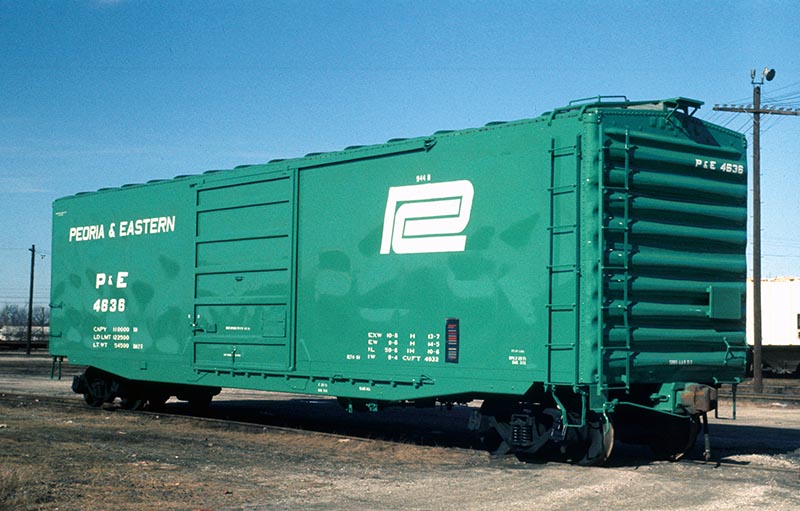
Fresh jade green paint brightens up a Peoria & Eastern boxcar. The P&E was a former NYC subsidiary that operated between Peoria, Ill., and Indianapolis, Ind. Kevin EuDaly collection
Disagreement between Penn Central and the New Haven over the value of the railroad assets delayed the actual takeover of the New Haven until January 1, 1969. Adding the burden of the New Haven may not have been the straw to break the proverbial camel’s back, but it certainly did not help Penn Central’s already precarious financial situation.
Bankruptcy
While the Penn Central was having its operational struggles, the company’s executive suite was just as dysfunctional, starting with its two top men — Stuart Saunders and Alfred Perlman.
Saunders had a background in law and had served as president of the Pennsy-controlled Norfolk & Western from 1958 to 1963, where he engineered its merger of the Virginian and laid the groundwork for the N&W’s acquisition of the Wabash and Nickel Plate. He was named president of the PRR in 1964, and his primary task was to ensure the PC merger was brought to fruition. This included negotiating with labor unions over job protection and utilizing his political connections in Washington, D.C., to convince labor unions and various departments of the federal government, along with the Supreme Court, that allowing the two railroads to merge would be in the best interest of the public.
Perlman, Saunders’ counterpart at the New York Central, climbed the ranks at both Burlington and Rio Grande in their engineering departments, then was hired as president of the New York Central in 1954 by its chairman Robert R. Young who had successfully won a proxy fight for control of the railroad. Perlman worked to cut costs, reduce debt, and modernize the railroad, but was unable to avoid having to seek a merger partner for survival.
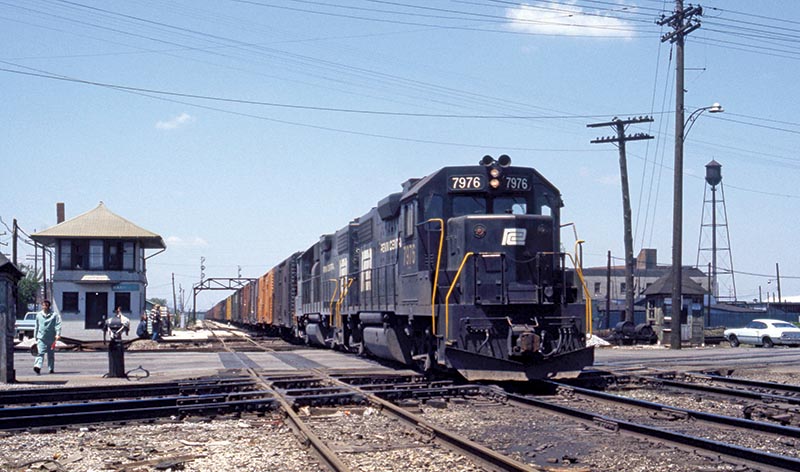
It looks like Penn Central, but we are one year into the Conrail era. A couple of ex-PC GP38s lead a freight cross the old Monon and Erie Lackawanna lines at Hohman Junction, Ind., in April 1977. Lou Gerard photo
On merger day, Saunders became chairman of Penn Central while Perlman became the railroad’s president, reporting to Saunders. However, they hardly saw each other since Saunders worked out of PC’s headquarters in Philadelphia and Perlman preferred to work out of the former NYC offices in New York City. They did not work well together nor did they trust each other. Such “Red Team/Green Team” infighting between former PRR and NYC managers trickled its way down through the ranks as time went on.
In his push to get the merger approved at any cost, Saunders agreed to contracts with the labor unions that provided for lifetime protection for any worker whose position would be eliminated by the merger. Consequently, Penn Central was unable to significantly reduce its labor force and was hampered in its effort to eliminate duplicate facilities and their respective employees.
As operations continued to melt down, customers who had the option began routing their traffic to other railroads. The decline in revenue, coupled with the higher operational costs, were the exact opposite of what, on paper, the merger was supposed to bring. Meanwhile, the company continued a PRR practice of investing in non-rail assets like pipelines, real estate, amusement parks, and an airline, diverting much-needed funds away from the railroad.
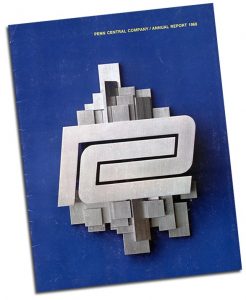 On December 1, 1969, Perlman was replaced as president with Paul Gorman, who had retired the month before as president of Western Electric. Perlman assumed the role of vice chairman, a meaningless position that removed him from day-to-day control of the railroad. Meanwhile, the debt continued to mount on PC’s balance sheet. Penn Central managed to successfully hide its financial situation from shareholders and creditors for the first couple of years, even paying out dividends in 1968 and 1969 despite losing millions of dollars.
On December 1, 1969, Perlman was replaced as president with Paul Gorman, who had retired the month before as president of Western Electric. Perlman assumed the role of vice chairman, a meaningless position that removed him from day-to-day control of the railroad. Meanwhile, the debt continued to mount on PC’s balance sheet. Penn Central managed to successfully hide its financial situation from shareholders and creditors for the first couple of years, even paying out dividends in 1968 and 1969 despite losing millions of dollars.
Winter 1970 was particularly bad for Penn Central, and not just because of the weather. Inflation, coupled with a retroactive wage increase, added to the railroad’s ongoing problems and resulted in an operating loss of over a million dollars a day for the first quarter of 1970. There was also $200 million in debt that was coming due by year’s end. The railroad could no longer hide the truth from its shareholders, the banks, or the public.
Financial institutions started to dump their Penn Central holdings while the railroad started seeking financial assistance from the federal government to stay afloat. The banks refused any further loans without a change in management. At a meeting of Penn Central’s board of directors on June 8, 1970, Saunders, Perlman, and Chairman of the Finance Committee David Bevan were relieved of their duties, and Paul Gorman assumed the role of chairman. However, the change in management did not delay the inevitable. After a last-ditch attempt to secure a government-guaranteed loan failed, Penn Central filed for bankruptcy protection under Section 77 of the Bankruptcy Act on June 21, 1970…
 Read the rest of this story in the February 2018 issue of Railfan & Railroad!
Read the rest of this story in the February 2018 issue of Railfan & Railroad!


